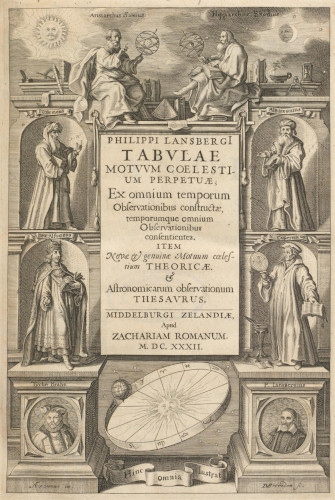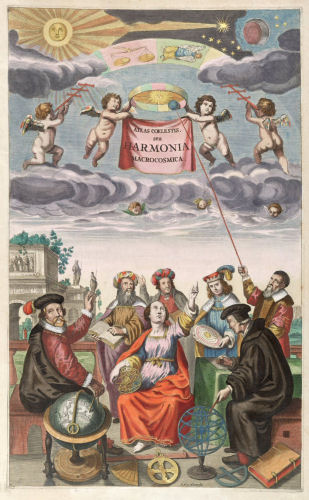

As in many astronomical and astrological publications from the 16th- and 17th century, the Harmonia Macrocosmica of Andreas Cellarius is embellished with an elaborate frontispiece depicting famous astronomers of the distant and more recent past.
 |
 |
| Frontispiece of the Tabulae Motuum Coelestium Perpetuæ (1632) of Philips Lansbergen | Frontispiece of the Harmonia Macrocosmica (1660) of Andreas Cellarius |
The frontispiece, measuring about 26½ by 43 centimetres, was engraved by Frederik Hendrik van den Hove (1628/29-1698). He was born in The Hague and worked in Antwerp, Amsterdam and London. As was pointed out by Ashworth (1985), Van den Hove’s design for the frontispiece of the Harmonia Macrocosmica and the choice of the depicted persons was largely based on the frontispiece of the Tabulae Motuum Coelestium Perpetuae of Philips Lansbergen (1561-1632), published in 1632 by Zacharias Roman in Middelburg (Zeeland).
The upper half represents the celestial vault with a radiant Sun, a crescent Moon, the stars and a portion of the zodiac with the signs of Virgo and Libra as observed by a pair of putti with cross staffs while another pair of putti uphold an emblem of the heliocentric world system and a banner with the book’s title.
The depicted persons in the lower half can be identified as follows: seated in the centre with an armillary sphere on her lap and a ruler, a mariner’s astrolabe and a quadrant at her feet is Urania, the muse of astronomy. Seated on the left is the Danish astronomer Tycho Brahe (1546-1601) with a celestial globe and a pair of dividers in his right hand, and on the right the Polish astronomer Nicholas Copernicus (1473-1543) with a graphometer at his feet and pointing at an armillary sphere.
Standing in the background at the left is the Greek astronomer Claudius Ptolemy (fl. A.D. 150), clad in a royal mantle and pointing to a passage in an opened book (the Almagest). Likewise clad in royal attire and standing to the right of Urania in the background is the Castilian king Alfonso el Sabio (‘the Wise’, 1221-1284), holding a model of the heliocentric(!) world system in his hands – an apparent error of the engraver as this properly belongs in the hands of Copernicus.
Although the person standing to the right and pointing upwards with a long stick to an emblem of the heliocentric world system somewhat resembles the Italian scientist Galileo Galilei (1564-1642), he is in fact to be identified with Philips Lansbergen. With the exception of Urania, all the earlier identified persons (and the emblem of the heliocentric system) can be traced back to the frontispiece of Lansbergen’s Tabulae Motuum Coelestium Perpetuae.
Thus far unidentified remains the person in the background standing behind Urania and apparently raising his hand to the viewer. He is the only person who, except for a closed book in his left hand, does not seem to have a distinctive feature that can identify him. Though he has tentatively been identified with the Islamic astronomer al-Battānī (c. 850- 929), as he is also present in the Lansbergen frontispiece, the lack of distinctive Oriental features suggests that he must be identified with someone else. Perhaps even, in style with Lansbergen’s frontispiece or that of Johannes Kepler’s Tabulae Rudolphinae (1627), he should be identified with the author himself. Unfortunately, this hypothesis cannot be verified as no portrait of Andreas Cellarius is known to exist.